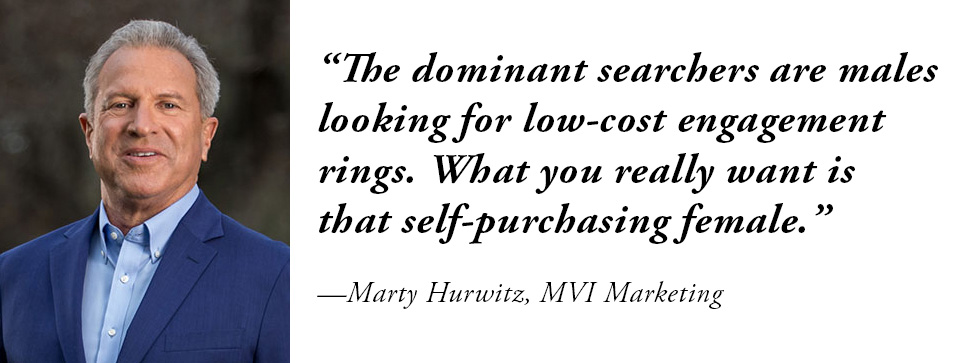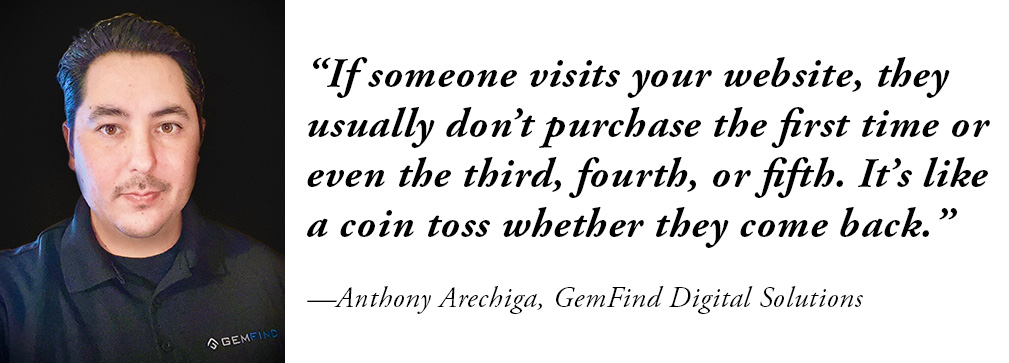Is digital advertising a business-saving tactic or a curse (or both)? JCK investigates.
Digital advertising was supposed to usher in a brave new world of ultra-efficient microtargeting, in which the fabled 50% of misappropriated advertising dollars would no longer be wasted.
Marketers would be able to tailor their ads to only the most receptive customers, and slice and dice their audience into ever-narrower demographic chunks. Companies would only pay for clicks, so they could both test their advertising’s effectiveness and avoid shelling out for campaigns that didn’t work.
At first, this seemed like heaven. Plus, digital advertising was cheaper; putting up a few words of text was less costly than filming a TV commercial.
But then two big names began to dominate the cyber environment: Google, now known as Alphabet, which also owns YouTube, and Facebook, now doing business as Meta, which also owns Instagram. The Google-Facebook duopoly accounts for 50% to 60% of all digital ad spend, according to eMarketer. And now, a third tech giant, Amazon, is a growing force in online marketing, increasingly relying on sponsored, rather than organic, results. Amazon accounts for nearly 10% of U.S. digital advertising, says eMarketer.
 The limited number of outlets and endless number of companies hoping to advertise on these platforms have made costs explode. Online advertising was already hot pre-pandemic, but the COVID-19 crisis put the marketplace into overdrive.
The limited number of outlets and endless number of companies hoping to advertise on these platforms have made costs explode. Online advertising was already hot pre-pandemic, but the COVID-19 crisis put the marketplace into overdrive.
According to Merkle’s Digital Marketing Report, in the third quarter of 2021 Facebook’s CPM (cost per thousand, or mille) for impressions jumped 46% over the prior year—even though Apple’s recent privacy-driven change to its iOS platform has made Facebook ads less efficient. The CPC (cost per click) for paid search rose 41%, the report said.
All of which has made the standard measurement for an ad’s effectiveness—CACs, or customer acquisition costs—jump 75% over the last few years, according to McKinsey. And as CPMs, CPCs, and CACs spiral ever upward, more CFOs are requiring CPR.
“The cost of customer acquisition has become extremely high,” says Marty Hurwitz, founder and CEO of MVI Marketing in Austin, Texas. “The pay [per] click can get really heavy when you’re competing against Zales or James Allen. People are spending 30% of their gross margins on marketing. That’s not normal.”
Hurwitz says the problem is particularly acute for jewelry brands. “The dominant searchers are males looking for low-cost engagement rings,” he says. “What you really want is that self-purchasing female. That’s where the lifetime value is. But that’s also really competitive.”
With these costs crushing big companies, how can smaller ones compete? It’s tough, experts say, but they give the following tips:

Follow Best Practices
As Anthony Arechiga, vice president of sales and marketing for GemFind Digital Solutions, puts it: “Do what Google tells you to do.
“Google is about page experience today,” Arechiga says. “That includes your mobile experience, site speed, but also the relevance of your pages to what people are searching for.”
He says Google (Alphabet) is looking for a dedicated page for every single category or search. “So if you’re jeweler in Denver, you create a page for engagement rings in Denver, another page for wedding rings in Denver, a page for custom jewelry in Denver,” Arechiga says. “So you basically have a homepage for every one of those keywords or search terms because those pages are going to be a lot more relevant to what the user was searching for.”
Category pages will not only improve your regular search ranking, but will also boost click-through on paid search. “With a better-quality score, Google will get you to show up higher on their ads,” Arechiga says. “You’ll spend less money when your page is more relevant.”
If jewelers find placing search ads on the main Google search engine too pricey, Arechiga notes that post-COVID, the company opened up a new service, Google Local, designed for small businesses. Advertising on Google Maps costs less, too.
 Learn to “Retarget”
Learn to “Retarget”
Google ads targeting the whole population are good for broad awareness, Arechiga says, but they don’t necessarily convert to purchases. And while it pays to efficiently target, sometimes the biggest rewards come when you retarget.
Retargeting involves contacting, usually through a social media or Google ad, consumers that have already checked out your site.
“If someone visits your website, whether that’s from a radio or TV ad or whatever, they usually don’t purchase the first time they visit, or even the third, fourth, or fifth time they visit,” Arechiga says. “It’s like a coin toss whether they come back. You have to remind them.”
Installing Facebook Business Manager gives companies a “tracking pixel” for their websites that links visitors to their Facebook accounts. After that, Facebook shows visitors an ad, reminding them of the site they just visited. This may have creepy privacy ramifications, but it’s hugely efficient, Arechiga says.
Keep Your Website Content Fresh
“It’s important for jewelers to create more content and blogs,” Arechiga says. “That positions them as thought leaders and helps with their search engine visibility.”
Team Up With Other Local Businesses
“A local independent can joint-venture with other independents in the market,” Hurwitz says. And if they tag each other on social media, they both win.
The same principle applies when jewelers join with a local charity. In that case, jewelers should make sure the local media know about the partnership. That means they will be tagged not only on the charity’s feeds, but on the media’s news pages, too.

Talk to Google and Facebook Marketing Pros
Brandon Cook, director of marketing at lab-grown diamond e-tailer Clean Origin, says his site is in frequent contact with marketing people at Google and Facebook. “If you are spending a good amount on advertising, they will make themselves available and give you more tools that help you out.”
Experiment With New Platforms
“You can’t rely on one or two channels,” Cook says. “When you find Google and Facebook have hit a ceiling, the question is, What’s next?”
Cook notes that video services like TikTok and Instagram Reels are currently getting lots of traffic and exposure. In a few months, that could change. Digital is all about trying new things. “It’s about experimentation,” he says. “You have to allocate 10% of your budget to see what works.”
Other digital advertising opportunities include podcasts, affiliate marketing, sponsored content, and streaming TV. Axios recently reported that some big direct-to-consumer companies are increasingly turning back to traditional channels, like TV, radio, direct mail, e-mail newsletters, and billboards. And, of course, many are opening up brick-and-mortar stores, which they see not just as sales vehicles but as “ads” that lend credence to their sites.
Take Brilliant Earth. The newly public e-tailer spent close to $50 million last year on advertising. On its recent quarterly earnings conference call, CEO Beth Gerstein talked up her company’s “sophisticated analytics” and “data-driven thematic approach.”
But Gerstein also added that two-thirds of Brilliant Earth’s customers are influenced by possibly the world’s oldest form of advertising: word of mouth.
(Top photo: Getty Images)

